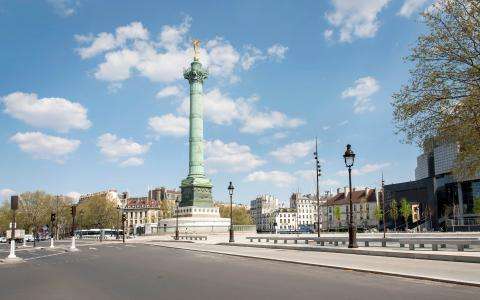The July Column and its memories of revolutionary Paris
Published on 1 September 2023, dans Visit Paris
Eastern Paris, comprising the old quarters, carefully preserves its popular identity. As a gathering place, the Place de la Bastille is truly the emblem of the fight for freedom. Indeed, the capture by the people of the royal fortress of the Bastille symbolically marked the beginning of the French Revolution on July 14th, 1789. Today, the square is dominated by the majestic July Column surmounted by its gilded statue of the Génie de la liberté, the story of which you might not know. During your stay at the Hôtel Marais Bastille, why not visit this magnificent monument, which the public can now enter?
Commemorate the various revolutions
In 1792, the location of the Bastille became the rallying point of the Revolution and later a popular gathering place during times of both unrest and celebration. It was therefore necessary to mark the space with a monument. This was achieved with the construction of a monumental fountain in 1793. Under Napoleon I, it was also decided to build a gigantic plaster elephant which was to overlook the fountain. Finally, the Three Glorious Days, the revolutionary period of July 1830, decided the fate of this monument. The base of the fountain was preserved and topped by a gigantic column, inspired by Trajan's Column in Rome. Inaugurated in 1840 to commemorate ten years since the Revolution of 1830, it adopted the style of ancient architecture, with Doric-style friezes and numerous symbols. Most importantly, it represented, as it still does today, the struggles for freedom and the Republic.
Deciphering the symbols
Previously, the interior of the July Column was off-limits to the public. Its doors, however, will be opened to all on October 21st. This presents a golden opportunity to discover more about the history of Paris in the 19th century, and especially the turbulent time of the revolutions. Although only the base of the monument can be visited, a tour offers a fascinating look at the crypt within. The monument houses a necropolis containing the remains of the revolutionaries of July 1830. Those who died on the barricades of the Revolution of 1848 were also laid to rest there. The carved stone walls, marble mosaic floors and stained-glass windows have been carefully restored. The guided tour of the monument allows you to relive tumultuous events and understand the allegorical significance of this column, which is so prominent in images of the great public gatherings of our time.
Just over a five-minute walk from the Hôtel Marais Bastille, the July Column tour takes you to the heart of the revolutionary history of Paris. It also gives a fascinating insight into Parisian urban geography, including the streets of the Marais, a former residential district of the nobles and upper middle class people of the 16th, 17th and 18th centuries, and working class suburbs such as Saint-Antoine, on the other side of the Place de la Bastille.
******
Photo : beatrix kido
Hotel Marais Bastille, a 3-star hotel a few steps from Place de la Bastille
